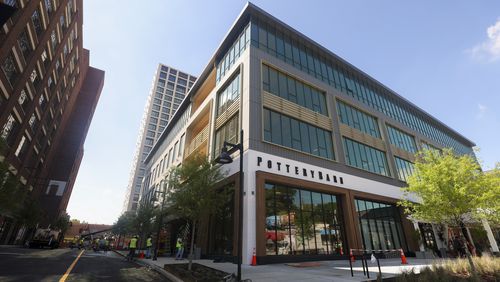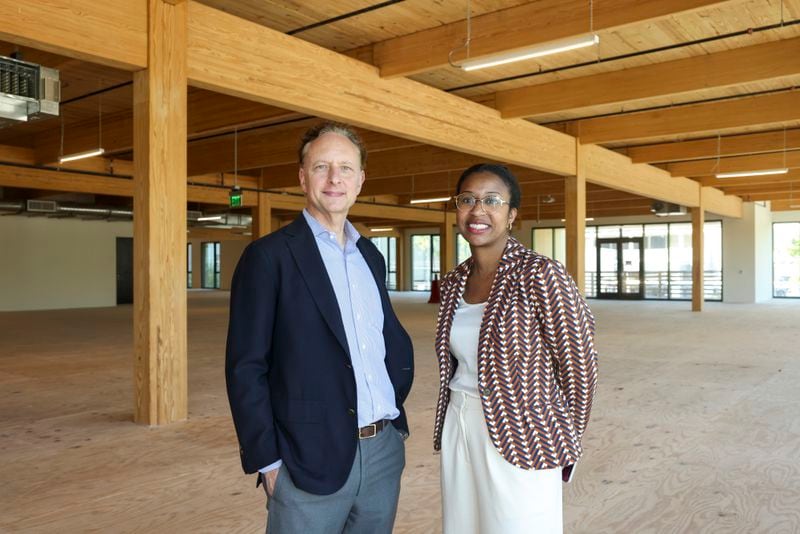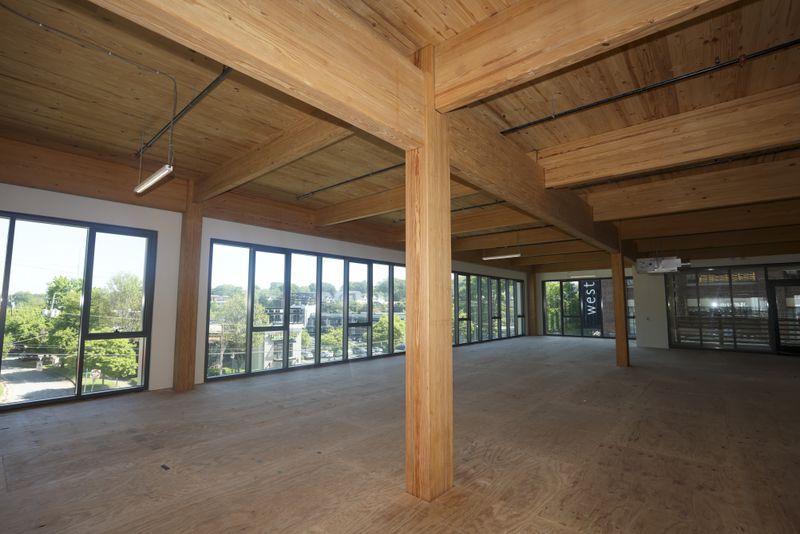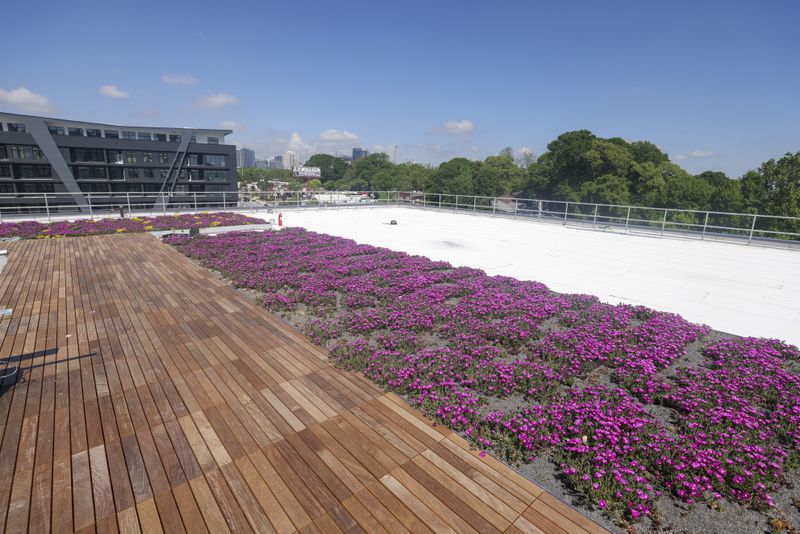Wrapped in gray paneling with ample windows, the exterior of the new four-story building at the corner of Ponce de Leon Avenue and Glen Iris Drive looks decidedly more modern than its hulking, brick neighbor, Ponce City Market.
But inside, the rich wood floors and timber beams overhead reveal that this mixed-use property is like few others in metro Atlanta or the country.
The building, known as 619 Ponce, was constructed entirely from timber grown in Georgia and manufactured by regional suppliers, using centuries-old techniques that are experiencing a revival as developers seek to reduce their environmental footprint. On Thursday, 619 Ponce officially opened its doors to the public in Atlanta’s bustling Old Fourth Ward neighborhood, just steps away from the Beltline.
Credit: Jason Getz / Jason.Getz@ajc.com
Credit: Jason Getz / Jason.Getz@ajc.com
The 115,000-square foot building was spearheaded by Jamestown, the company behind Ponce City Market and several other properties in the area. Those include the recently completed Signal House, a residential development that towers over the Eastside Beltline, and Scout Living, a still-under-construction hospitality concept next door to 619 Ponce, which will offer flexible lengths of stay when it opens later this year.
The 619 Ponce building is made of mass timber, a catch-all term for a range of engineered wood materials with the strength to serve as a structure’s load-bearing bones, in place of the steel and concrete that are typically used in commercial buildings today.
Heavy timber construction has been used for centuries in churches, schools and more. And while modern mass timber buildings are more common in Europe, the technique is catching on in Atlanta and around the U.S.
In Atlanta, the T3 building in Atlantic Station was built using similar timber techniques. The structures also meet fire safety codes.
Producing steel and concrete requires lots of energy and in turn, results in emissions of huge amounts of carbon dioxide and other greenhouse gases that are heating up the planet. The wood in mass timber, on the other hand, stores carbon that would otherwise be in the air contributing to global warming.
Credit: Jason Getz / Jason.Getz@ajc.com
Credit: Jason Getz / Jason.Getz@ajc.com
Most mass timber used in the U.S. is imported from Europe or Canada. For 619 Ponce, Jamestown used a regional supply chain, a first for a mass timber building in Georgia, the company says. Doing so was challenging, but the environmental benefits were worth it, said Matt Bronfman, the CEO of Jamestown.
“You’re sort of undercutting your sustainability story if you’re bringing your timber in on a slow boat from somewhere else in the world,” said Matt Bronfman, the CEO of Jamestown.
The wood itself is southern yellow pine harvested from Georgia forests, including from timberland Jamestown owns and manages near Columbus. The wood was converted into lumber at a Georgia-Pacific sawmill in Albany, and then laminated into panels and beams at a plant in Dothan, Alabama, run by SmartLam. The onsite construction — akin to assembling a large LEGO set, Jamestown executives said — was completed by the engineering firm StructureCraft and the construction company JE Dunn.
Utilizing mass timber and manufacturing it all locally resulted in emissions reductions of 75% compared to a typical concrete building, Jamestown says.
Andres Villegas, president & CEO of the Georgia Forestry Foundation, called 619 Ponce a blueprint for how “a local forestry supply chain can unlock meaningful reductions in carbon emissions in the built environment while supporting Georgia’s greatest natural asset — its working forests.”
Beyond the environmental upside, Bronfman said there are other perks to using mass timber.
“Let’s be honest, it’s prettier,” he said, standing in one of the building’s airy open floors beneath golden wood beams. “Being in a building like this is simply a better experience in a lot of ways.”
Credit: Jason Getz / Jason.Getz@ajc.com
Credit: Jason Getz / Jason.Getz@ajc.com
The home furnishing retailer Pottery Barn has already opened an 18,000 square foot outpost on the ground floor, and the accounting and HR firm Sage has leased 57,000 square feet on the top two floors. Overall, the building is about 67% leased.
The modular assembly mass timber allows reduced construction overall construction time, Jamestown said.
There are a few drawbacks, primarily the cost. Alexandra Kirk, a vice president of development and construction at Jamestown, said the building’s total price tag was still being finalized, but estimated the premium the company paid for mass timber versus concrete and steel was less than 15%.
Jamestown’s hope is that completing this building and establishing a supply chain will make future mass timber projects cheaper. The company said it doesn’t yet have firm plans to start another mass timber construction yet, but it is considering it for other properties it owns in Metro Atlanta and other cities.
-Staff reporter Zachary Hansen contributed to this report.
A note of disclosure
This coverage is supported by a partnership with Green South Foundation and Journalism Funding Partners. You can learn more and support our climate reporting by donating at ajc.com/donate/climate/
About the Author










